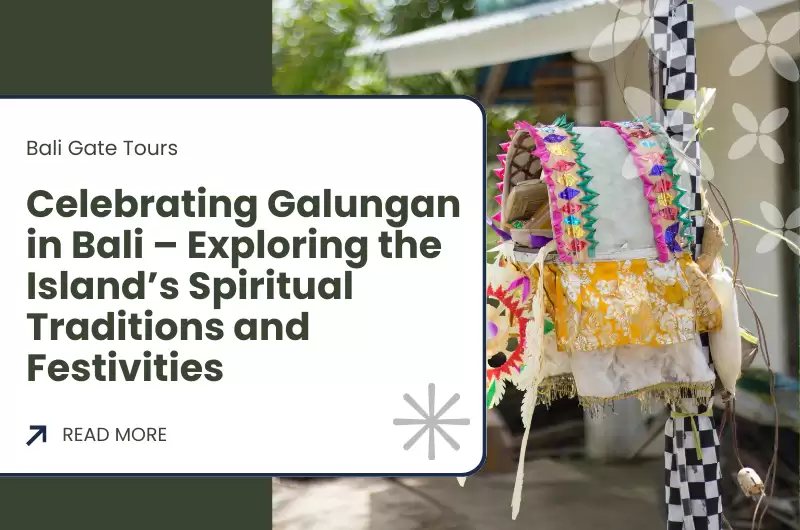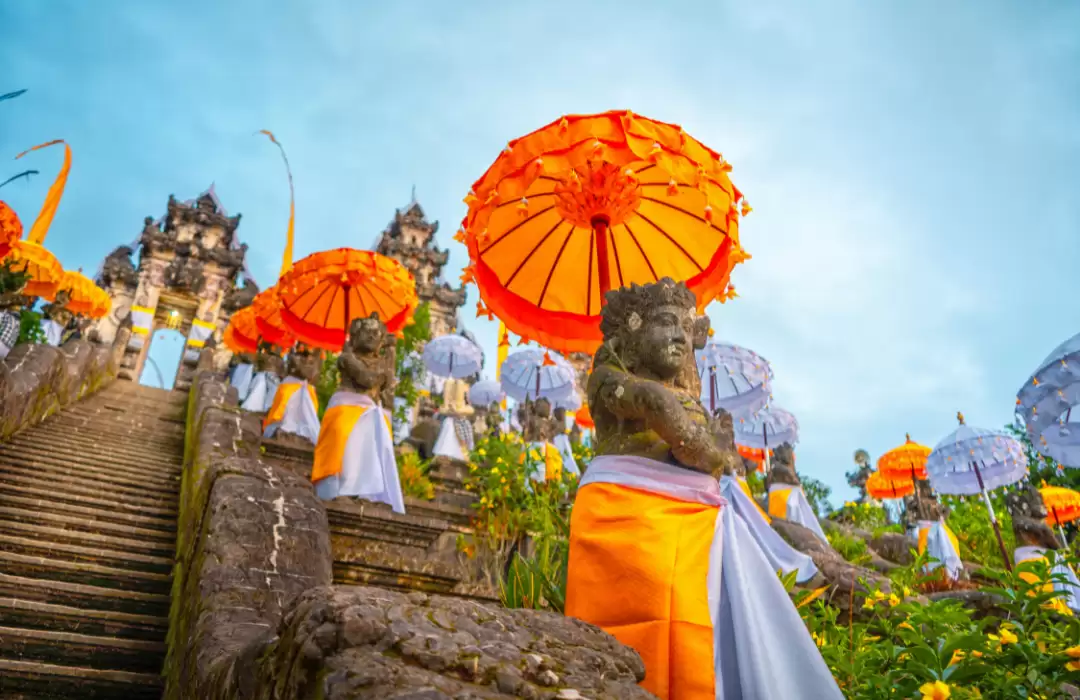Celebrating Galungan in Bali – Exploring the Island’s Spiritual Traditions and Festivities

Bali is an island that lives and breathes spirituality, where daily life intertwines with its Hindu-Balinese traditions. Among the many celebrations that take place throughout the year, Galungan stands out as one of the most significant and deeply cherished festivals in Bali’s spiritual calendar. For Balinese Hindus, Galungan marks the victory of good over evil, celebrating the return of the gods and ancestral spirits to the island to visit their families. The festival is a time of reflection, offering, and communal celebration that resonates with both locals and visitors alike.

Celebrated every 210 days according to the Balinese pawukon calendar, Galungan brings the island to life with vibrant processions, intricate temple rituals, and joyous family gatherings. The festival lasts for ten days, culminating in the observance of Kuningan, the final day of celebration. During this time, Bali’s temples are adorned with penjor (decorated bamboo poles), offerings are made in every home, and the sound of traditional gamelan music fills the air. It’s an immersive cultural experience that offers a glimpse into Bali’s deep connection to its spiritual beliefs.
For those visiting Bali during Galungan, this is an opportunity to witness a cultural celebration unlike any other. It’s a time when the island’s spiritual landscape truly comes to life. In this article, we will explore the significance of Galungan, how it’s celebrated, and where you can go to experience the festival’s most iconic rituals and traditions.
The Spiritual Significance of Galungan – A Festival of Good and Evil
The core essence of Galungan lies in its spiritual meaning. In Balinese Hinduism, the festival celebrates the victory of dharma (righteousness) over adharma (evil). It marks the return of the dewa (gods) and leluhur (ancestors) to Earth, where they are believed to visit their families and bless them with prosperity and harmony. It is a time when the Balinese people offer gratitude and seek divine blessings for the well-being of their families, communities, and the island as a whole.
One of the most important elements of Galungan is the act of giving offerings to the gods and ancestors. The Balinese believe that by performing these rituals, they strengthen their relationship with the spiritual world, ensuring blessings for themselves and their families. These offerings, often made with rice, flowers, and fruits, are placed at temples, household altars, and in the open air. The penjor, a beautifully decorated bamboo pole, is one of the most visible symbols of Galungan. These poles, adorned with coconut leaves, fruits, and flowers, are erected outside homes and temples as a symbol of gratitude and a conduit for spiritual energy.
Galungan is not only a time for religious observance, but it also marks a time of reunion for families. The festival brings families together, with Balinese people returning to their ancestral homes to celebrate with loved ones. It is a time of joy, togetherness, and reconnection with both the spiritual realm and one’s family roots.
Local Tip: If you are in Bali during Galungan, take part in the processions and offerings ceremonies in the temples or in local villages. Bali’s culture is most vivid during this time, and it’s a beautiful opportunity to witness the island’s spiritual devotion firsthand.
How Galungan is Celebrated – Rituals, Ceremonies, and Offerings
The celebration of Galungan is marked by several important rituals and ceremonies that take place throughout the island. The first day of Galungan is the most significant and is celebrated with a grand ceremony in the temples. Temples such as Pura Besakih (Bali’s mother temple) and Pura Tanah Lot are focal points for worship, as Balinese Hindus gather to make their offerings and perform prayers.
During the festival, penjor (decorated bamboo poles) are erected in front of homes, temples, and businesses. These poles, which can be as tall as 15 meters, are adorned with coconut leaves, flowers, and fruits, representing offerings to the gods. The penjor is not only an aesthetic feature of the festival, but it is also a symbol of fertility, prosperity, and spiritual connection. As visitors walk through villages, the sight of penjor towering over streets and temple entrances creates an atmosphere of reverence and beauty.
One of the most important days during the Galungan festival is Minggu Kuningan, when the gods are believed to return to the heavens. The last day of Galungan, Kuningan, marks the culmination of the celebrations, with Balinese Hindus preparing special offerings for their temples and family altars. These offerings typically consist of yellow rice (symbolizing prosperity) and a variety of fruits, all placed in small baskets made of banana leaves. The spiritual significance of Kuningan is deeply rooted in Balinese tradition, as it’s a time for families to offer their thanks to the gods and seek blessings for the coming year.
Where to Experience Galungan – Best Locations to Witness the Festival
Bali’s villages come alive during Galungan, as each village has its own unique way of celebrating the festival. While Ubud and Denpasar are central to Bali’s cultural life, there are several other locations that offer a more authentic and intimate experience of Galungan.
Ubud is undoubtedly one of the best places to witness Bali’s cultural celebrations during Galungan. The town is home to many of Bali’s most important temples and spiritual sites, including Pura Taman Saraswati and Pura Gunung Lebah. During Galungan, Ubud is decorated with penjor and temples host ceremonial offerings. Ubud’s tranquil atmosphere and rich cultural heritage make it an ideal location to witness the sacred Balinese rituals firsthand.
For a more intimate experience, head to the mountainous regions of Tegallalang and Sidemen, where you can explore traditional villages that are deeply rooted in Balinese spiritual practices. Here, you’ll find smaller, less touristy temples that offer an authentic experience of Galungan, with locals welcoming you to observe their rituals and celebrations.
In Denpasar, the capital city of Bali, Galungan is celebrated with grandeur. The Kumbasari Market in Denpasar comes alive with traditional dances, street food, and bustling activity as locals prepare for the Kuningan ceremonies. While Denpasar is more urbanized, its cultural heart beats strongest during the Galungan festivities.
For those seeking a truly spiritual experience, visiting Bali’s sacred temples such as Pura Besakih on Mount Agung during Galungan is an unforgettable experience. This temple complex is Bali’s holiest site, and it becomes a focal point for worshippers during the festival.
The Culinary Delights of Galungan – Traditional Foods to Try
No celebration in Bali is complete without indulging in the island’s traditional cuisine. During Galungan, special dishes are prepared to celebrate the festival and offer thanks to the gods. The highlight of Galungan’s food offerings is Babi Guling (suckling pig), a ceremonial dish that is roasted and served with rice, spicy sambals, and vegetables. Babi Guling is traditionally served during family gatherings and is a symbol of abundance and prosperity.
Another essential dish during Galungan is Lawar, a type of salad made from vegetables, grated coconut, and spiced meat (often chicken or pork). It’s a flavorful dish that combines the earthy taste of tropical herbs with the rich flavors of Balinese spices. Often accompanied by rice and sambal matah (raw sambal), Lawar is a must-try dish during the festival.
For those with a sweet tooth, Dadar Gulung (a green pancake filled with sweet coconut) and Kue Cubir (traditional layered cakes) are served as desserts during Galungan. These treats are often made and enjoyed in the home as part of the festival’s offerings.
During Galungan, food is much more than just sustenance; it is an offering, a sacred ritual, and a symbol of gratitude. As you explore Bali during the festival, make sure to sample these traditional dishes to truly experience the island’s spiritual connection to food.
Embracing the Spirit of Galungan – A Time for Reflection and Celebration
Galungan is more than just a festival; it is a time for spiritual renewal, family reunions, and celebrating the timeless connection between Balinese Hindus and their gods. For visitors to Bali, Galungan offers a unique opportunity to experience the island’s rich traditions, vibrant rituals, and deep sense of community.
Whether you’re in Ubud, Denpasar, or the mountain villages, witnessing the Galungan festivities will allow you to connect with Bali’s spiritual soul and understand the island’s cultural heart. The sacred rituals, the festive atmosphere, and the culinary delights make Galungan a time of joyous celebration, reflection, and connection with both the past and the future.
As you explore Bali during this sacred time, take a moment to appreciate the spiritual significance of the festival and the cultural richness that makes Bali such a special destination. From the temples to the offerings and the family gatherings, Galungan is a celebration of life, prosperity, and the eternal connection between the divine and the human.










